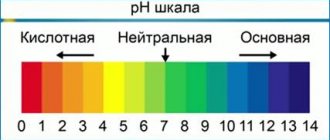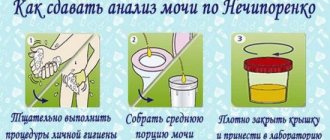Preparation
Special preparation for urine collection for urine analysis according to Zimnitsky is not required.
You must first agree with your doctor about stopping diuretics (diuretics) on the day of urine collection.
The patient should record the amount of all fluids consumed on the day of urine collection (water, tea, coffee, juices, soups, and intravenous drips) and provide this data to their doctor along with the test results.
You must first obtain 8 sterile containers from the laboratory or purchase them at the pharmacy. Also at the pharmacy you need to purchase a container for collecting urine with graduation to determine the volume of each portion of urine.
Urine collection procedure:
Urine is collected throughout the day.
At 6 o'clock in the morning, empty your bladder, pour this portion of urine into the toilet, its volume is not recorded.
Over the next 24 hours, 8 portions of urine are collected every 3 hours (until 6 o'clock the next morning).
- 1st portion - from 06:00 to 09:00
- 2nd portion - from 09:00 to 12:00
- 3rd portion - from 12:00 to 15:00
- 4th serving - from 15:00 to 18:00
- 5th portion - from 18:00 to 21:00
- 6th portion - from 21:00 to 24:00
- 7th portion - from 24:00 to 03:00
- 8th portion - from 03:00 to 06:00
Urine collection is carried out in a dry, clean, graduated container.
After each urination, it is necessary to record the volume of the collected portion (for example, 256 ml).
Then the urine in the container needs to be mixed and some (about 60 ml) poured into one sterile container, the remaining urine should be poured out.
On the container write the volume of the entire portion and the time of collection of this portion.
Close the container tightly with a lid and store in the refrigerator at a temperature of +2...+8°C.
Thus, you need to collect 8 portions of urine per day.
The next morning, deliver all portions to the laboratory.
IMPORTANT! If you did not urinate during a certain period of urine collection (for example, from 15.00 to 18.00 hours), then an empty container must be delivered to the laboratory. On the empty container, indicate the time interval and serving volume - “0 ml”.
There is no need to get up specifically at night to urinate if there is no urge to urinate.
What is daily, hourly and minute diuresis?
Assessing the volume of urine excreted allows us to identify problems in the functioning of the paired organ. Deviation from normal values is also one of the factors signaling a circulatory disorder.
It is practiced to measure the volume of urine produced over different periods of time:
- The daily amount of urine is the main indicator when assessing the functioning of a paired organ. To measure, you need to drink about two glasses of water in the morning (after sleep). Pour the first urine down the drain. Collect all subsequent urine excreted during the day in a specially prepared container. It is necessary to record the time of each act of urination and the amount of urine. The collection of biological fluid lasts exactly one day. In addition, after the first act of urination, blood is taken from the patient for clinical analysis and biochemistry.
- Minute diuresis is the volume of urine excreted per minute. Allows you to identify the glomerular filtration rate of the kidneys (a marker of kidney aging). To measure it, the daily value is divided by 1440. Ideally, such diuresis should be in the range of 0.55-1 ml.
- Hourly is a simple and reliable indicator that allows you to judge the condition of patients who have lost a lot of blood. To measure it, a catheter is inserted into the bladder. At low values (less than 15 ml), the doctor increases the volume of intravenous fluid injected to compensate for blood loss.
Interpretation of the result
At the medical office, you can get personal advice from a doctor from the “Doctor Q” service on interpreting the results of the study during your appointment or by phone.
It must be remembered that interpretation of the results of a urine test according to Zimnitsky should only be carried out by a doctor, since the results of laboratory tests are not the only criterion for making a diagnosis and prescribing appropriate treatment. They should be considered in conjunction with medical history and the results of other possible examinations, including instrumental diagnostic methods.
An adult normally excretes approximately 67–75% of the liquid he drinks during the day. Daytime diuresis should exceed nighttime and amount to 2/3–3/4 of the total amount of daily urine. The relative density during the day ranges from 1.005 to 1.025 g/ml.
If night diuresis predominates over daytime diuresis, then this indicates a decrease in the concentrating ability of the kidneys. Nocturnal predominance of diuresis is often found in diabetes insipidus and heart failure.
An excess of urine density above 1.025 g/ml is observed in cases of dehydration, pyelonephritis, and uric acid diathesis in children.
A decrease in urine density below 1.005 g/ml indicates a decrease in the concentration function of the kidneys and occurs in renal failure, chronic glomerulonephritis and pyelonephritis, diabetes insipidus and diabetes mellitus, hyperaldosteronism, while taking diuretics, severe potassium deficiency, excess calcium,
To confirm the resulting pathological abnormalities, the doctor may prescribe stress tests to the patient to dilute and concentrate urine.
Day and night proportions
All urine that is excreted per day can be divided into daytime and nighttime. During daylight hours, all processes important for life work at full strength, so the formation and excretion of urine occurs with the greatest intensity. If we evaluate the volume of daytime and nighttime diuresis, then their ratio is 4:1. This means that with healthy kidneys and other organs of the urinary system, four times less fluid should be released during sleep than during wakefulness.
The phenomenon in which nighttime diuresis predominates over daytime diuresis is called nocturia. This symptom leads to lack of sleep and decreased performance. May indicate serious problems with the kidneys or abnormalities in the cardiovascular system.
What does it depend on
The volume of urine and its quality depend on several factors:
- The amount of fluid drunk (normal, the ratio of consumed and excreted fluid is 1:0.75).
- Age (children and older people urinate more often than adults).
- Weight (slimmer people excrete more urine when drinking liquid in equal quantities; in obese people it depends on the volume of water required per unit body area).
- Climatic environmental conditions (in hot countries, people have less daily diuresis due to profuse sweating).
- The amount and duration of physical activity (also affects the removal of fluid through the skin).
- Quality and composition of food (Dryer, carbohydrate foods retain water in the body).
- Daily diuresis in children is assessed depending on age.
The baby's bladder is small, so despite frequent urination, the volume of fluid released is small. In the first two to three days after birth, daily diuresis is about 40 milliliters. Every day the amount of urine excreted per day increases, and by the seventh day it is 150 milliliters. After two weeks - 250 ml.
How to determine
Daily diuresis is used as a way to assess the functioning of the genitourinary system, and, in particular, the function of urine excretion.
Urine is collected in a special container for 24 hours. In this case, the patient keeps a diary of the water he drank (or any other liquid) for the same period of time.
Algorithm for measuring daily diuresis:
- Three days before the study, you must stop taking diuretics and blood thinners.
- At the same time, you should not eat foods with coloring pigments.
- Mandatory hygiene before urination.
- The very first portion of urine after waking up must be poured out; it is not taken into account. Next, all subsequent urine is collected in a special container.
- Store in a cool place.
- The urine volume per day is recorded.
- A small portion of collected urine is sent to the laboratory.
To do this, fill out a form with patient data, which includes:
- FULL NAME.
- Age.
- Height (in centimeters) and weight.
- The volume of urine collected per day.
- The time during which the collection took place.
Next, the laboratory assistant conducts research.
Diuresis disorders
A person should eliminate approximately 75% of the liquid he drinks per day. A decrease in its volume, as well as excessive secretion, indicate problems in the functioning of the body.
Causes of low daily urine volume
A reduction in diuresis is indicated as follows:
- Oliguria – slowing down the process of urine excretion (up to 400 ml per day). Observed in cases of nephritis, kidney or heart failure, dehydration, severe blood loss, urolithiasis.
- Anuria is the complete absence of urine in the bladder. It can be caused by severe nephritis, meningitis, shock, obstruction of the urinary tract, poisoning, and inflammation of the peritoneum.
Why is urine output exceeded?
An increase in daily diuresis is called “polyuria” (2-3 liters of urine per day). It can be healthy and pathological. In the first case, polyuria may be a consequence of drinking large volumes of water or taking diuretic products (for example, watermelon). This condition is considered normal and does not require special attention. Diuresis will return to normal values on its own.
Also, the volume of diuresis increases in some diseases:
- diabetes;
- swelling;
- urinary tract infections;
- Conn's syndrome;
- nervous system disorders;
- taking diuretics and glycosides;
- acute renal failure.
Self-medication can be harmful to human health. If you show signs of illness or suspect it, you should immediately consult a doctor.
Methods for determining diuresis
Diuresis is determined by collecting urine samples. The main indicator is the total volume of urine compared with the norm of urination.
To understand how much urine a particular person produces, the doctor prescribes a urine test for a certain period (24 hours, 12 hours). The study also takes into account other indicators:
- presence of sediment, mucus or blood in the urine;
- smell;
- consistency.
All these characteristics are important when assessing diuresis. They more fully reveal the process of formation and excretion of urine.
Varieties
Diuresis is called diurnal because it is divided by time of day into daytime (urination from 9:00 to 21:00) and night (from 21:00 to 9:00). In a healthy person, daytime always significantly predominates over nighttime (approximately 4:1).
- If nocturnal diuresis becomes more frequent, it is called nocturia.
- Based on the volume of urine excreted, there are:
- Urine output exceeds three liters – polyuria.
- If up to 500 milliliters - oliguria.
- Less than 50 – anuria.
Based on the ratio of the volume of urine excreted to the density of osmotic substances, diuresis is:
Osmotic - an increased amount of urine with a fairly high density. Diabetes mellitus, use of diuretics, and chronic renal failure lead to this type.
Water diuresis (the density of osmotic components is reduced due to an increase in the volume of water drunk).
Antidiuresis is an unfavorable condition that develops against the background of acute pathology and is manifested by fluid loss in unnatural ways (repeated vomiting, diarrhea). With this type of disorder, a high density of osmotic substances is observed.
Recommended topic:
Difficulty urinating in men
Diuresis is called forced if it is created artificially: drinking large amounts of water in a short time with the use of diuretics. This method is used for acute poisoning and the need for urgent removal of toxins.
Normal daily urine output
Up to the age of 10, urine excreted in children is calculated using the formula:
600+100x(n-1),
wherein:
- 600 is a constant value (it is taken from the volume of urine of a 1-year-old child per day (in ml)).
- 100 – annual increase (by age (in ml)),
- n – number of years.
The average daily diuresis in an adult is between one and two liters. For children, everything is different and depends on age. Normal values are given in the table.
A newborn urinates 20-25 times per day. As you get older, the frequency decreases. They also look at other indicators that increase with age. The data is in the table.
Average statistical norms of diuresis in children
Recommended topic:
Treatment of difficulty urinating in men
| Child's age | Single volume of urination (in ml) | Amount of daily urine (in ml) | Number of urinations (per day) |
| 1-3 months | 20—40 | 180—600 | 20—25 |
| 4-6 months | 260—690 | ||
| 7-9 months | 285—750 | 15—16 | |
| 10-12 months | 350—820 | ||
| 1-3 years | 40—60 | 620—880 | 10—12 |
| 4-5 years | 890—950 | 7—9 | |
| 6-7 years | 60—100 | 1060—1250 | |
| 8-9 years | 1130—1310 | 7—8 | |
| 10-11 years | 1210—1400 | 6—7 | |
| 12-13 years old | 100—200 | 1300—1500 | |
| Over 13 years old | 1500—1900 |
Deviations from the norm
The physiological functioning of the urinary system in a child may be disrupted due to some changes in the body. These include:
- infectious diseases of the urinary system (pyelo- or glomerulonephritis);
- impaired renal blood supply (atherosclerosis);
- congenital anomalies (polycystic disease, hypoplasia);
- mechanical damage to urine excretion functions (UCD);
- intoxication (sepsis).








